In my previous Quest column I offered some recommendations about how to choose a digital camera, addressed to our typical readership: serious amateur photographers, who, for one reason or another, did not yet switch to (or even venture into) the digital domain.
Here are the promised recommendations, chosen with such a Reader in mind. Be warned that these recommendations are probably tainted with a personal bias, but this is difficult to avoid.
The recommendations will be split into a number of camera types, as outlined in the previous installment. When you set your mind on one of these classes, it would be useless to try to persuade you away from it you must have had some reasons. If you want a small, pocketable camera as a backup to your OM-4, I'm not going to talk you into getting an SLR, and vice versa.
In each category I'll be listing two models I'm familiar with and which, I believe, deserve a recommendation. Some rationale will also be given, although do not expect me to prove my choices.
Note of June, 2005: The article has been originally written six months ago: I re-post my Quest pieces online with some delay as not to compete with the printed newsletter. This version has been updated to reflect new developments on the market and also some changes in my preferences, but most of the original recommendations and remarks remain valid.
Category 1: Optical Finder Compacts
From these cameras you would expect, in addition to pocketability, a decent image quality, ease of use, yet a range of manual adjustments or overrides. Maybe this is a camera you want to carry along when traveling really light, or just a backup for your main workhorse ("My other camera is a Hassie, you know...").
Last September I did a serious research within this category, buying a new camera for my wife, who, although not technically oriented, wants to get serious about photography, but not serious enough to carry something not fitting into her purse.
After checking out about twenty models, and scrutinizing hundreds of samples, there was no doubt: from the viewpoint of image quality, the Canon S60 came clearly on the top. This lens not only has an extremely useful EFL from 28 to 100 mm (expressed as EFL, i.e., in terms of 32-mm film camera lens angle), but it really delivers: the samples were just second to none in terms of sharpness and optical flaws.
The new Canon S70 adds improved cosmetics and more megapixels (seven instead of five), but this does not make much difference). If you can get the S60 at a significantly lower price, this would be my recommendation; otherwise go for the S70.
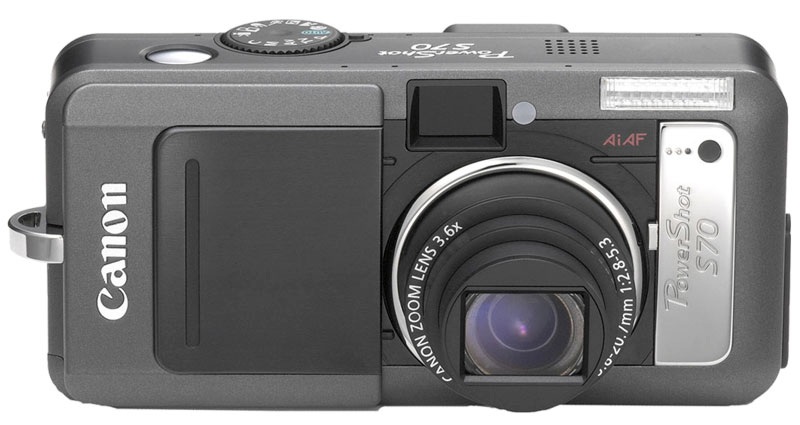
A close second was the tiny Olympus C-60Z. This is a six-megapixel camera, but it would be equally good with four megapixels, as this is more within the limitations imposed by the tiny lens.
June 2005: Consumer Reports (July, 2005 issue) just listed the C-60 as a Best Buy in its class, along with the Fuji E550; at $280 or so I consider it a steal.
The camera is smaller and seems to be better made than the Canon; in addition, it offers a convenient, one-button exposure adjustment. True, its lens has a more limited range, from 38 to 114 mm EFL (I'm missing the wide angle) and is clearly not as good as Canon's, but good enough for most uses.
The advantage of smaller size, plus easy exposure override were the main reasons why we finally decided on this model, not the S60. (A more demanding user may be better off with the latter, though.)
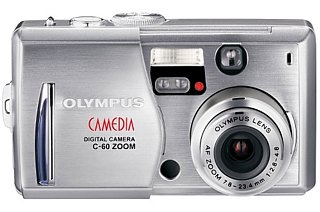
Be warned that there are quite many mediocre cameras in this category; most are significantly worse than the models I'm recommending, from almost any angle.
Category 2: Optical Finder, Regular Size
These are cameras not unlike classic rangefinder Leicas. While missing interchangeable lenses, they provide the same functionality by means of lens attachments. You would expect better lens specifications and quality, plus the full range of various settings, enough to satisfy a serious photography buff.
My original choice in this category was the Olympus C-5060WZ. With a 27-110 mm (EFL) lens, a bit dark at the long end, but very usable, and with good-quality attachments adding the EFL of 19 mm at the short end, and 187 mm at the long one (with the attachments, however, you have to resort to electronic viewing).
Five megapixels seem just enough for this camera, and image quality (especially color rendition) is first-class, comparable to that of SLR cameras costing much more.
June, 2005: This model has been replaced with the C-7070WZ, essentially the same (read: very good) camera with more pixels, predictive autofocus, and slightly improved LCD monitor.
(Note: The '7070 has, I believe, addressed the mode dial problem plaguing the '5060. Still, if you buy the '5060, I would recommend getting an extended warranty, just in case.)
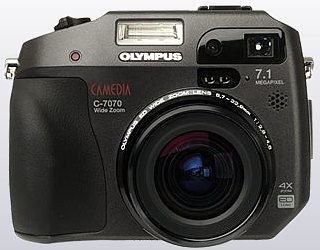
An older Olympus model, C-5050Z, has a zoom which is not as wide at the short end, but much brighter, and, I tend to think, of higher quality. The '5050 is a delightful, very well made camera running on AA-sized batteries, and if you can snatch one cheaper than the '5060, it may be a good choice. (While discontinued for almost two years, the '5050 still seems to have a dedicated following, and used ones in good shape may not be easy to find.)
Another high recommendation goes to the Canon G6. Much ergonomically improved from the preceding G5 (including a shape similar to that of recent Olympus and Nikon models, not the G5's brick), the camera has an excellent 35-140 mm EFL lens; while not as wide as that of the '5060, it is brighter: F/2.0 at the wide end, and F/3.0 at tele.
The jump in resolution from 5 to 7 megapixels is of rather secondary importance.
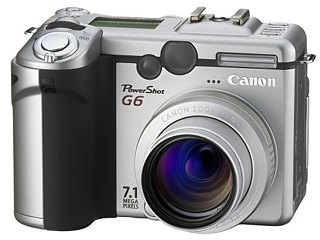
The Nikon Coolpix 8400 (eight megapixel seems to be an overkill for this sensor size!) has very attractive specs, including a 24-85 mm EFL lens, but I have no experience with it at all, so I wouldn't risk any recommendation (pro or con). The previous, similar Nikon viewfinder model, 5400, did not impress me when I tried it out. Still, the camera has many followers, and check it out.
Category 3: Single Lens Reflex
All current cameras available in this category offer virtually everything most of us need in terms of image quality, specs and controls, so the choice is driven more by the camera ergonomics and feel than the other considerations.
I really like the Olympus E-1. Some people criticize it for "only" five megapixels, but with the 4:3 image ratio the pixel resolution approaches that of other models with 6MP, and the Kodak imager in the E-1 is one of the best available. Don't be fooled by numbers.
The results from the E-1 are very good, and the camera, in addition to providing better images than a 35-mm SLR, is built like a tank, and a pleasure to handle. Importantly, the unique dust removal mechanism seems to be working, something still to be matched by any other manufacturer.
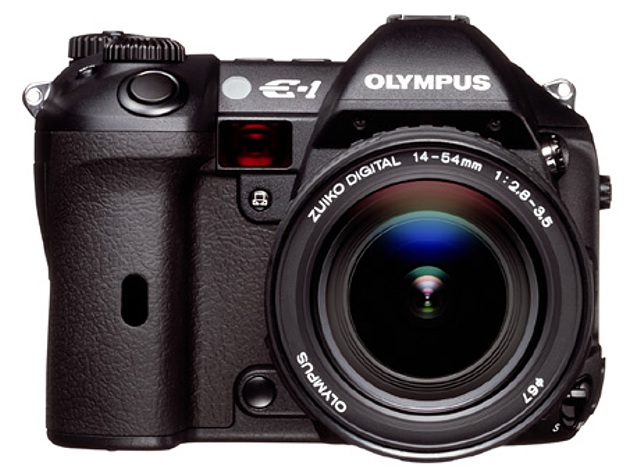
The more affordable, slightly simplified Olympus E-300 is the SLR I'm using now, and I like it a lot — both the build quality and the results. It seems to make good use of the eight-megapixel sensor, and also has the ultrasonic dust removal system, unique to Olympus.
A kit consisting of the E-300 body and two "economy" zooms (combined EFL range of 28-300 mm) is priced at less than $1000; a perfect entry into a digital SLR system. Risking the wrath of Canon and Nikon loyalists ("If it ain't Scottish, it's crap!") this is the SLR I'm recommending to people whom I suspect to have a taste similar to mine.
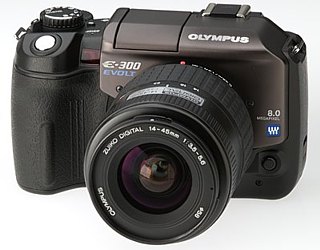
The interchangeable lenses for the E-1 and E-300 are optically top-notch and impressively specified (no hand-me-downs from film cameras!), albeit quite expensive. The less costly alternatives from Olympus and Sigma, while of limited choice, deliver respectable results, as I was able to check.
Just recently I've tried the Canon EOS 20D. I must say this is a very strong contender (although priced about 30% higher than the E-1).
In this model Canon, at last, got almost everything right (except for the general "feel", but this is subjective), after the 10D which I found somewhat disappointing in more than one aspect.
In particular, high (1600) ISO settings are quite usable, in spite of the camera's CMOS sensor. In general, the 20D competes successfully against cameras costing twice as much.
The original Canon 300D did not impress me at all (feeling quite cheap); the new 350D is nicer, but I haven't used it enough to advice for or against it.
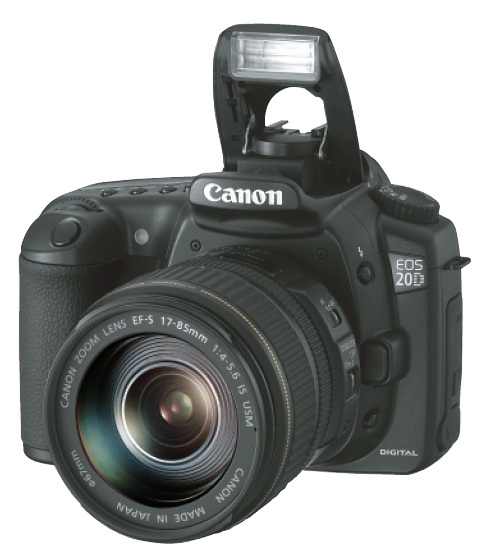
What makes your choice in the SLR category more difficult is that all current digital SLRs are capable of very good results (a situation very different than that in the compact class).
Trying to choose the "best" one becomes largely a matter of your personal preferences. I know someone who loves the Pentax *ist DS, and someone who returned one to the store after three days. I also agree with those who say that the controls in the Minolta Maxxum 7D are just second to none, and this may be enough to steer you in that direction. My advice is to try the models you consider and listen to your feelings.
Concluding Remarks
You might have noticed that I'm not making any recommendations in the class of electronic-viewfinder cameras. This is because I believe that most of Quest readership, having grown up on optical viewing (SLR or direct), will not be willing to live with electronic finders. Myself, I dislike them a lot.
This was just a quick listing of my choices. As mentioned, it would be beyond the scope of this article to justify, or "prove", my pickings. These, additionally may be tainted with personal biases and preferences; this is hard to avoid. You may treat my recommendations as a starting point in a research you do on your own; in any case refer to my Choosing a Digital Camera piece in the previous issue for a list of points to focus on.